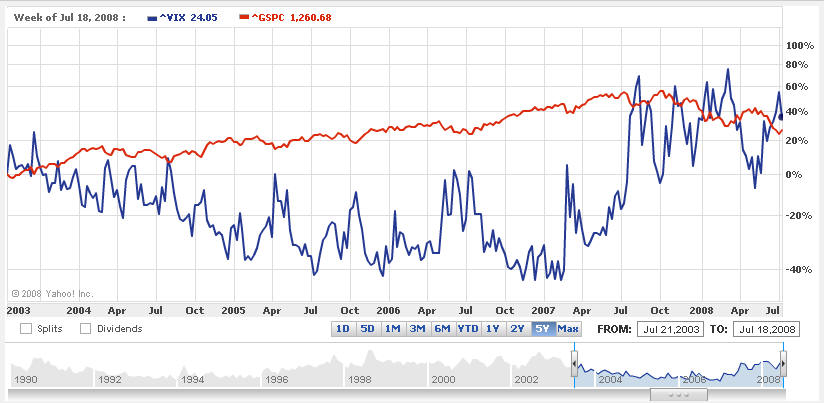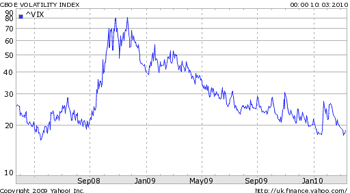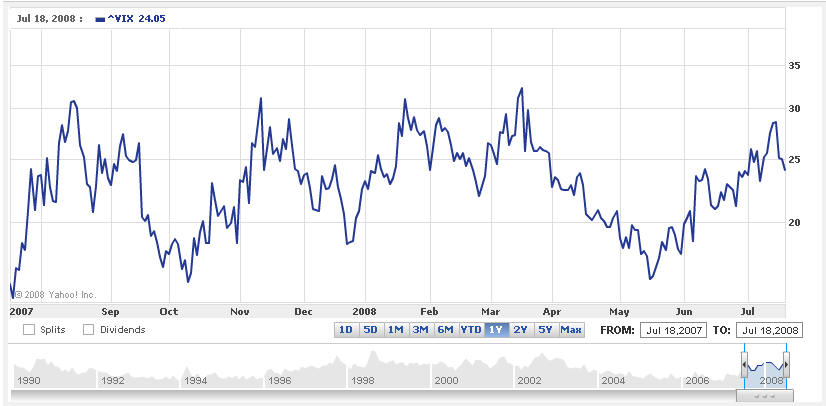Trading the VIX - Betting on Volatility
Traders who wish to speculate on market volatility may want to consider opening a spread betting position in CBOE volatility index (VIX) futures. How can you do this? For the last few years the financial markets have measured volatility using the VIX index, also known as Wall Street's 'fear gauge' because it measures anticipated volatility in America's S&P 500 index. Since volatility often signifies financial turmoil and the Vix is much more sensitive to market falls than rises, it is sometimes referred to as the 'investor fear gauge'. With spread betting brokers you can gain exposure to markets, such as the Vix, that would not otherwise be readily accessible to non-professional investors.
VIX Index. At the time of writing (Mar 2010) the VIX is trading at the bottom of its 2 year range.
VIX Index - Spread Betting on Volatility
- Volatility in capital markets is tracked by the Volatility Index. The VIX, as it is referred to, is the ticker symbol for the Chicago Board Options Exchange Market Volatility Index, a popular measure of the implied volatility of S&P 500 index options. The VIX is considered the index that predicts stock market moves. Also known as the fear index, a number of investors use this volatility index to determine whether it's a good or bad time to be in the market.
- Volatility is usually seen as a good measure of risk; the higher the volatility the greater the risk (and reward). Volatility also tends to increase in the phase from bull to bear markets and changes in volatility are good predictors of shifts in sentiment and the beginning of new trends.
- The volatility of the S&P 500 index is published and can even be traded or spread bet. The VIX index is 'calculated' as a positive percentage and represents the expected volatility of the S&P 500 index over the next 30 days. i.e. the Vix Index measures implied volatility of options on the S&P 500
- The creator of the VIX index, Professor Robert Whaley, used it to measure the price paid to buy 30 day option contracts in connection to the price of shares transacted on the Save & Prosper 500 (S&P 500 index). Thus, the VIX index does not measure the volatility in shares but tracks trading in options (an option provides the holder a choice to buy or sell shares at a set price at a certain point in the future) on the S&P 500 to indicate how much traders expect the market to move over the next month. This is because options are commonly used as insurance against the value of a share falling or rising - and the VIX index measures the relationship between the options bought and sold.
- Because the VIX is based on real-time option prices, it reflects investors' consensus view of future expected stock market volatility. 'During periods of financial stress, which are often accompanied by steep market declines,' the CBOE Website explains, 'option prices - and VIX - tend to rise. The greater the fear, the higher the VIX level. As investor fear subsides, option prices tend to decline, which in turn causes VIX to decline.' As stockmarkets fall, volatility, and therefore the VIX, tends to rise and vice-versa (because historically markets typically fall much faster than they rise).
- So the VIX index basically shows how volatile options traders expect the S&P 500 to be over the month ahead. The higher the number the greater the predicted changes in prices as the writers of options charge bigger premiums. The VIX is the most popular measure of volatility, however, there are a number of other indices which measure volatility such as the VXO, the VXN (for the NASDAQ-100 index), and the RVX (for the Russell 2000 small cap index). In addition to volatility indices for US equities, there are also volatility indices for international indices (VDAX, VSTOXX, VSMI, VX1, MVX, VAEX, VBEL, VCAC, etc.) as well as lesser known volatility indices for other asset classes such as currencies.
- The VIX index was first introduced in 1993 and was refined ten years later, the index now being a weighted blend of prices for a range of options on the S&P 500. The 'original VIX' (which is still tracked under the ticker VXO) differs from the current VIX in two main respects: it is based on the S&P 100 (OEX) instead of the S&P 500; and it targets at the money options instead of the broad range of strikes utilized by the VIX. The current VIX was reformulated on September 22, 2003, at which time the original VIX was assigned the VXO ticker. Calculated as a percentage, the VIX reading represents the expected movement, or volatility, in the S&P 500 over the next 30 days, on an annualised basis.
- A low reading - of say 10 - implies the S&P 500 is expected to move up or down by 2.9% over the next 30 days. A high reading - of say 40 - would indicate a swing of 11.6% either way is anticipated.
- A rising VIX indicates a switch from complacency to a state of anxiety - a state usually caused by a stock market decline.
- Low VIX values of less than 13 (usually reached when markets are already very high) can presage nasty market falls while readings above 30 are associated with high levels of volatility due to investor uncertainty. Traders buy put options when they are scared and think markets will fall. This is akin to human nature. If the vast majority of players grow too fearful, the markets will defy them and surge higher. And if the vast majority grows too greedy and complacent, the markets start brazenly spiraling lower to trap the longs. The majority is always wrong at major turning points.
- VIX measures market sentiment and indicates the level of anxiety or complacency in the markets. A low reading is an indication of complacent investors who are at ease about the steady gains they are seeing in their portfolio and so are less likely to buy call options (which give the owner the right to buy at a pre-determined price) as they are already profiting from their share price gains. Moreover, they are more likely to sell 'out of the money' call options against their positions to enhance potential gains.
- The VIX index is often used as a contrarian indicator for speculators. High VIX values above 30 (likely to be reached when the stock market is very low) means that investors are very scared (means also that price of options is very expensive) and can presage that the market may be getting ready to turn back up. Low VIX values of less than 13 (likely to be reached when the market is very high) can represent complacency and can indicate the market may be at risk of peaking and due for some profit taking. While I have here focused on the VIX based on the S&P 500, remember that the S&P 500 still affects European markets greatly as European shares tend to move in tandem with their US counterparts, so even if you are not trading US markets, the VIX is worth watching.
- If the VIX is at 15, this represents an expected annual change of 15% thus one can infer that the index option markets expect the S&P 500 to move up or down 4.33% over the next 30-day period.
Since the beginning of the year, the index has traded at a median of close to 27. This means that the average investor believes that there is a one-in-six chance that the S&P 500 index will fall 8 per cent or more over the next month. In 2007, the average level of the Vix was 17 and, in 2006, it was 13 (meaning the average trader believed there was a one-in-six chance of the index rising or falling 3.7 per cent in the next month).
- As a point of reference, the VIX hit 41 after the terrorist attacks of 11 September 2001 as markets were extremely nervous. However, just a few days afterwards, markets rebounded and the VIX fell.
- So extreme fear levels of 35+ may signal a good entry point for shorting the VIX and/or buying the S&P. Selling high volatility is usually safer than buying low volatility as low volatility tends to last for longer periods of time.
- Please note that although the VIX is certainly an interesting indicator to help gauge investor sentiment, it should not be relied on without further support.
- It is worth noting that although in the past turmoils in the markets has rarely pushed the VIX to much over 40, in October 2008, the credit crunch spiked the intraday cash market price of the new VIX to an all-time high of 89. Moreover in the last years or so volatility spikes have also become ever more common, going back to the Asian crisis of 1997 to World Trade Center attacks. In addition, it is not just price gyrations that have increased, but the 'volatility of volatility' itself.
- So what happens in very volatile market conditions? As a general rule traditional investors are more inclined to withdraw their monies from investments that are considerer higher risk and reinvest the proceeds for the short term in assets that are thought to be less risky. Funds flow out of stock investments and move
in short term bonds/treasuries and other sovereign debt.
- A number of spread betting providers offer spread bets on the VIX index. The spreads are narrow, typically just 0.1 of a point and the minimum bet size is typically between £20 ($30) and £50 per index point.
 |
How to Trade Volatility using a Spread Betting Provider
The VIX can be used as a hedging tool due to its strong negative correlation to the SPX and also it is 4 times more volatile. If you believe the market has risen too quickly and way too far then you should go long volatility. For instance, if the market is not properly pricing in all of the downside risks and volatility is relatively low, then you should think about taking a long position. In fact some fund managers often find that buying out of the money calls on the VIX to be a relatively inexpensive way to hedge long portfolio positions. Similar hedges can be constructed using VIX futures and options.
Most USA brokers, or spread betting firms for UK and European investors, allow traders to take a position on volatility through access to VIX futures or VIX options. The spreadbet is based on the VIX which is quoted in the USA (market is open from 2.30pm until 9pm GMT; although for spread betting purposes this doesn't really make any difference for us as the spread betters desks are open round-the-clock). For instance with IG Index you can gain exposure to the VIX index using spread betting. The bid-offer spread is at 0.1-point, in addition to any market spread. The minimum bet size is £50 per index point, and all bets settle against the relevant VIX futures contract on the CBOE. Each point is the equivalent of 1 index point and can be traded like the other indices.
- Priced in £ per point, a bet on the VIX has the same notional trading requirement (NTR) as an S&P options bet (400x stake).
- The Chicago Board Options Exchange, home of VIX, is open from 2.30 pm until 9.15 pm Monday to Friday.
- Settlement is against the last traded price and expiry occurs on the Tuesday prior to the third Friday of the month.
For instance: August volatility is trading at 23.95/24.20. If I believe that volatility is likely to increase I could buy £1,000 a point at 24.20. In this case I would profit £1000 for every full point the index moves upwards. Suppose that after a few days VIX is trading at 24.50/24.75 and I close the spread bet at 24.50. Buying to open at 24.20, and then selling at 24.40, is a movement of 0.3 of a point. So at £1,000 per point this would be a profit of £300 at IG Index. The minimum bet size is £100 a point, which is a relatively small bet.
So a spreadbetter who foresaw rising volatility could go long on the VIX, and short on the stock market by selling one of the main US indices.
>> Options Spread Betting Basics
For currency trading InterTrader is hard to beat...
EUR/USD from just 1 pip, GBP/USD from just 2 pips...
Trade over 60 major and exotic currency pairs with very few requotes.
plus the trading platform is INSTANT and reliable with free professional charts.
Apply for an Account.
|
The content of this site is copyright 2016 Financial Spread Betting Ltd. Please contact us if you wish to reproduce any of it.



